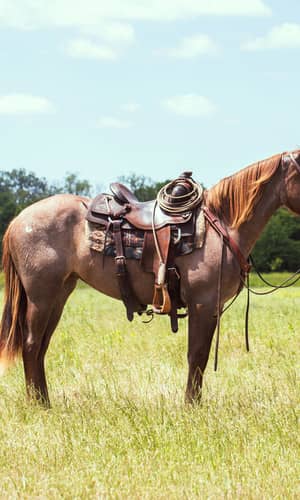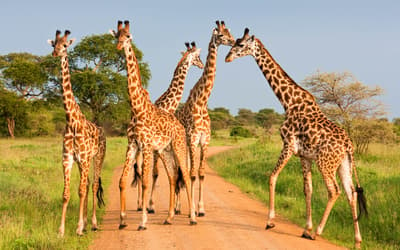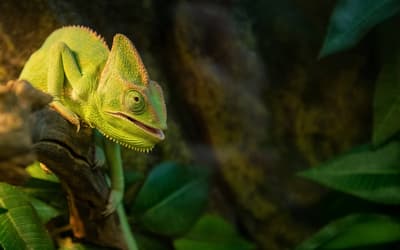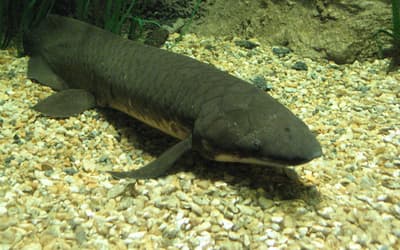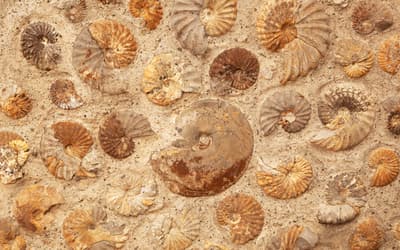The views expressed in this paper are those of the writer(s) and are not necessarily those of the ARJ Editor or Answers in Genesis.
Abstract
Horses have served as one of man’s closest companions for thousands of years. Humans have ridden them into battles, attached them to the plow, galloped them across great plains, and shown them in countless competitions. Found anywhere from ranches, to back yards, to racing tracks, to beaches, these magnificent animals have been used as instruments which brought great change into the world. One might even wonder how easily man would have managed to advance without them. With such close ties to man’s history, it seems natural that one should ask if horses were designed for riding. Such is the topic of this article and the research thereof. In considering different subjects such as History, Anatomy, and Scripture, it is this author’s belief that horses were designed to be ridden.
Keywords: anatomy, design, equine, history, riding, Scripture
Introduction
Were horses designed to be ridden? This is a question which, surprisingly, has been overlooked amongst both the scientific and equine community until more recent years. As to why this is the case is not entirely known. Considering that the horse- human relationship has persevered for hundreds, even thousands of years, it is quite ironic. Horses have carried human beings for numerous purposes, whether for daily transport, categories of competition, leisure, warfare, or agriculture. Nations relied heavily on the aid of these creatures for the progress of civilizations. Horses not only made for faster transportation, but also quicker communication. One could accurately state that they were one of history’s “backbones.” Thus, with so much equine involvement, it is curious as to why comparatively little research has been committed to this topic.
This paper will first conduct an overview associated with this question. The following section will discuss the limited research concerning the topic, design implications for worldview, the historical impact of horses, and animals which have been ridden throughout history. Next, the most common objections raised against horses being designed for riding will be given and answered. These objections will be discussed:
(1) Poor design,
(2) Horse pain and irritability, and
(3) Kissing Spines.
Lastly, passages from Scripture will be given to demonstrate that God did design horses to be ridden by human beings.
It is the desire of this author to lead readers to an awe of God in seeing how the horse was intentionally designed and made for a certain purpose.
Overview of Topic
Before exploring the arguments for and against whether horses were designed to be ridden, a brief overview of background issues related to this topic will be given. First, the state of research on the topic will be addressed. Next, the implications for worldview will be considered when discussing design. Then, the historical impact will be shown. And lastly, consideration will be given to animals which have been ridden throughout history.
Limited Research
Unfortunately, authors who have spoken to the topic of whether horses were designed to be ridden are usually dismissive to the idea. For example, the authors of Equine Science, simply state: “The horse is not designed to carry a rider’s weight on top of its back” (Pilliner and Davies 2004, 23). However, no explanation is provided in the text as to why the authors dismiss the idea.
Another example can be found in the popular book, How to Think Like a Horse by equine author Cherry Hill. In this work, she states that “A horse’s body isn’t really designed to carry extra weight, but it can by virtue of its suspension-bridge features” (Hill 2006, 50). Soon after, she adds: “Even though a horse is not designed to carry weight, because of the cooperative interaction between major topline ligaments and the circle of muscles, with careful consideration, we can ride” (Hill 2006, 52). The implication, then, from the author is that horses were not designed to be ridden. According to the text, horses at least have the capacity to be ridden but were not designed for such a role.
Numerous blog articles have been written on this topic of discussion as well. Sadly, these authors’ views also tend to be quite dismissive. In her article, “The Horse’s Body is not Designed to Carry a Person,” Didier (2019) states: “when we objectively assess what really holds a riding horse back we have to admit something quite awkward, and that is—from a design, strength, and balance point of view—the horse’s body is simply not designed to carry a person.” In this article, she at least provides reasoning for why she believes horses were not designed to be ridden, and it is due to their back structure in relation to where a rider sits.
In the article, “Were Horses Meant to be Ridden by Humans?”, Stone (2022) flatly opens with “Horses were never meant to be human slaves and carry them on their backs.” His explanation is the recurring theme about a horse’s anatomy, in addition to back pain caused by riding.
Design Implications
It is this author’s belief that the primary reason as to why the topic has received so little attention is mostly due to the implications of design. If horses (or their kind) were designed for a very specific purpose, this would suggest the existence of a Designer, along with accountability to that Designer. Such an idea certainly runs contrary to evolutionary teaching. Could a supreme Being have created a certain kind of animal to carry humans? Did our Creator design animals to benefit man in various, specific ways? Scripture provides numerous examples of man benefitting from the animal kingdom. Therefore, it is reasonable that rideability is one of the specific benefits that God has given man to utilize. This certainly fits within the dominion mandate of Genesis 3 and man’s freedom in how he implements his stewardship of creation.
Historical Impact
In view of history, there is no debate that civilizations have ridden horses for a very long time. Both people of antiquity and people of today have observed, experienced, and recorded this. By and large, both evolutionists and creationists agree that horse domestication began roughly 3,000-6,000 years ago, potentially from the very beginning. And since that time, humans have been perfecting the process of taming animals, particularly equines. Contrary to the repeated evolutionary story, there is no reason to think that it would have taken long for people to see the potential uses for horses. These quadrupeds obviously had the strength to carry a person. And even though other animals have been ridden throughout history, none have been as comparable to the success of the horse with a rider. Willekes (2016, 4) states: “No one can say when exactly someone first realized he could climb onto the back of a horse and harness equine power for his own advantage, but once it happened the horse-human relationship changed irrevocably.” From a creationist perspective it is important to note that utilizing the horse’s rideability was not caused by or a result of sin being in the world, even though man could have used them for evil purposes. Without the horse, people would have still made achievements. However, the horse would prove an incredible aid to human beings. Plainly, one of the key reasons why horses have made so much impact is because they are rideable.
Animals Ridden Throughout History
As touched on previously, other animals throughout history have been ridden as well. The horse kind is certainly not the only kind of animal that humans have tamed and ridden. For example, camels largely were and still are a common beast of burden in the Middle East and other parts of the world. Ancient civilizations used them for multiple purposes, including warfare. In addition, man has utilized elephants. Historians can note that the infamous war monger Hannibal of Carthage rode elephants in his campaigns against the Roman Empire. Elephants are still ridden today, though typically for entertainment. And, lastly, other creatures such as reindeer, elk, moose, and even ostriches have also been ridden throughout the centuries.
Should Horses Be Ridden?
People have been asking questions about horses for generations. A vast amount of content has been published on matters such as the origins of domestication, horse nature and/or behavior, training horses, riding horses, whether horses like to be ridden, and even how horses should be ridden. Still, as mentioned before, there is comparatively little research that even approaches the present topic.
Following is a discussion of the most common objections to the idea that horses should be ridden. These objections are poor design, horse pain and irritability, and Kissing Spines.
Poor Design
Secularists will sometimes use terms along the lines of “poor design” when it comes to considering the rideability of horses. For instance, Adamson (2022) directly says, “Horses are actually a poor design for riding, and they are simply not evolved to be doing the sports etc. that we do with them.” From an evolutionist’s view, horses were not designed to be ridden. Problems in a horse’s anatomy occurring over time seem to be their proof of this. But do problems in the anatomy negate intelligent design and special purpose for the horse, or is it a secular attempt to suppress the existence of a Creator? It is rather hypocritical for evolutionists to argue that “poor design” throughout the universe disproves the existence of an intelligent Designer God while at the same time dismissing examples of wonderful design as evidence for God. Either the quality of design matters or it does not—it cannot only matter when designs “are poor.”
All issues happen in a context, and so one must consider the context. For example, it is very important for one to give thought to the activities in which equines are often placed. Horses can perform very well, even under pressure. But, as Didier (2019) notes, “Every design has its purpose and its limits.” Stated clearly, competitors often place equines in events which make very significant demands on the animal. In fact, it is not uncommon for animals (or humans) to get injured in these events. Thomas (2005, 1) affirms, “We often ask horses to perform tasks that are more demanding than anything they would do naturally.” The problem is not necessarily always the events, nor is it due to “poor design.” The problem is often the demands people put on the animal.
In the article, “Back Pain and Your Horse,” McLoughlin (2014) states: The horse’s back is not naturally structured to take the degree of downward pressure that modern riders apply. The long muscles in the back are poorly designed for such force. However, through conditioning, specialized exercise and riding techniques, we have encouraged these areas to become stronger.” Previously, in a quote from Hill, the author noted that a horse’s back contains “major topline ligaments” and is circled with muscle (2006, 52). She also mentions in her book that a common rule of thumb is that the average horse can carry up to at least 20% of its body weight (Hill 2006, 50). This more than easily handles the average weight of a rider. In answer to McLoughlin’s statement, the muscles in a horse’s back are far more rigid than many people truly understand. The horse’s back has, essentially, been treated by various authors as a flimsy structure, when, in reality, it is quite the opposite. The Creator has woven the horse with powerful design.
In her article, “The healthy-backed horse,” Lesté- Lasserre (2017) states:
The equine back is an intricately designed structure, capable of supporting the horse’s body mass and shape—as well as a rider. But to keep that back healthy and pain-free, we need to be conscious of the structures at play and, more importantly, how to build muscles in the area to keep it strong. By implementing proper training and riding techniques, making our own fitness a priority, and recognizing early signs of pain and pursuing treatment, we can be sure our horses’ backs remain the powerhouses they were designed to be. (Emphasis mine)
Lesté-Lasserre’s statement is a refutation to any authors’ attempts to treat the equine back as a flimsy or weak design for riding. The truth is quite the opposite. The author not only acknowledges the equine back as “intricately designed,” but also as being designed for a purpose. The fact is a horse’s back does support a rider.
If horses were designed to be ridden, what evidence should one expect to find? The answer is a back with features strong enough to bear the weight of a human. It seems obvious (as many authors will acknowledge) that the horse’s back is very reinforced with muscles and other components. This is why horses (under normal circumstances) can so easily bear the weight of a rider. One primary—and very important— muscle which stretches the length of a horse’s back is known as the Longissimus Dorsi muscle. Concerning a webinar led by Gillian Higgins, Limpkin (2022) writes that “It is a common misconception that the muscle in the horse’s body that supports the weight of the rider is the long back muscle ‘Longissimus Dorsi.’” Later, she shares, “longissimus is actually a gymnastic muscle designed to extend the back, laterally flex the back and to assist in the transfer of forces from the hind limb of the horse forwards through the body. It really isn’t a postural muscle designed to hold the weight of the rider at all.”
It is not this author’s intention to ignore the listed functions of the Longissimus Dorsi muscle. However, it is the belief of this author that the location and strength of the Longissimus Dorsi may have great significance, being more than just what some might consider a ‘happy coincidence’ of being located where riders sit. If this muscle did have one more function— such as carrying a rider’s weight—then, of what consequence is it? The answer to this question is the implication of a Designer. It is the very location where hundreds of thousands of riders throughout history have easily and successfully ridden. Thus, there is good anatomical reason to suggest that horses were meant to carry riders. Henry (2023) states: “The Longissimus Dorsi is the strongest muscle in a horse’s body. It originates from the last four cervical vertebrae and extends down the spine to the pelvis. This muscle raises and supports the head and neck and is used for rearing, kicking, jumping, and turning. It also is used to support riders.” While some sources (such as Higgins) would argue that this particular muscle was not designed to bear weight, it seems more than convenient that the strongest muscle in a horse’s body is right where riders sit. The Longissimus Dorsi muscle functions (as Limpkin notes) to extend the back, laterally flex the back, and assist in the transfer of forces from the hind limb to the rest of the body. However, the muscle also easily functions to support a rider. All functions of this muscle play a role in a human successfully riding a horse.
Other animals’ anatomy also has a Longissimus Dorsi muscle. For example, camels have a Longissimus Dorsi muscle and have been ridden. However, not all animals have been rideable or had near the success with humans than that of the horse. In Didier’s (2019) article, she makes this claim: “As fate would have it, the most convenient place for us to sit on a horse is possibly the weakest of all.” However, it is the opinion of this author that Didier is completely wrong in her claim and the truth is the opposite. Where a rider sits is on top of the strongest muscle in a horse’s body—which is more than able to carry a human.
Regarding the idea of “poor design” in relation to the horse’s back, another factor to consider is a horse’s age and development. Oftentimes, horses are placed into human-regulated activities in which the animal is ill-prepared both physically and psychologically. Sipila (2024) points out that in the world of show jumping trainers will often start jumping horses far too early. While horses can be trained from a young age, their bodies still need time to mature.
In addition to age and development is the aspect of degeneration. As horses age, their bodies become less efficient or able to perform activities in which they were once fluent. From the biblical model, it is part of the sad reality of living in a fallen world context (Genesis 3; Romans 8). All creatures degenerate. They lose their former vibrancy and strength. When a rider makes demands on an older horse that can no longer perform at peak capacity, extensive demands could prove harmful. Whether too young or too old, a horse’s age truly does affect the creature and its capacity.
Next, some horses may be unfit for riding due to emaciation. Amongst many of the details in equine history, there is also a horrific narrative of poor stewardship. Attempts to ride a malnourished or unfit horse could prove disastrous.
Hill lists an important aspect on how much weight horses can carry, and that is a horse’s breed (Hill 2006, 50). Perhaps unknown to some audiences, the world today contains many different breeds of horses, some in fact quite small. Were these designed to carry a rider as well? There are two things to remember here:
(1) Human intervention has been the cause of the wide variety of horse breeds today, and
(2) Even small horse breeds have been successfully ridden by humans.
While numerous authors may argue that horses should not be ridden and deny they were meant to be ridden, the presence of back issues does not at all prove that horses were not made to carry a rider. Despite different complications that horses can experience, they remain rideable and perfectly built for that purpose. Wilson (2023) affirms, “Horses were built to carry weight on their backs.” Human beings fit very well on top of a horse, and, under normal circumstances, horses can easily bear the weight of a human. They are not “poorly designed” for such a role.
Pain and Irritability
Concerning horse nature and behavior, some authors (for example, bloggers) used to inaccurately object that if a horse expresses signs of pain or irritability, this is proof that horses were not designed to carry a human and should not be ridden. Currently, however, these authors seem to have removed their articles. Agreeably, a horse’s behavior should not be discounted, as this is typically a reliable indicator of health-related issues. However, like other subjects, horse behavior is often misinterpreted and the exact cause for irritation may not even be related to riding activity. Riding is not the only context in which horses are found.
Kissing Spines
Kissing Spines (or Baastrup’s disease) is a common condition that horses develop in their back. In fact, a great amount of research has been conducted on this one disease. Anonymous (2023) defines Kissing Spines as “overriding (or impinging) dorsal spinous processes” along the horse’s back. The writer provides insight about this disease:
The exact cause of kissing spines has been the subject of debate since it was first identified. Theories of its origin have ranged from a predisposition for the condition due to the horse’s age, sex, height, or breed, to poor saddle fit, rider fitness, and improper training. It was previously speculated that some horses were genetically prone to kissing spines, and our research has now indicated that may indeed be the case.
Later, the author writes:
Kissing spines often occur within the last few thoracic vertebrae (T10–18), which are where a rider and saddle are positioned on the horse’s back. Because of this, there is reason to believe that poor saddle fit, improper training, rider skill, fitness, and weight could all be playing a role in the development of the disease. These are all examples of non-heritable risk factors that horse owners can be mindful of in the big picture of preventing the development of kissing spines.
Obviously, a number of factors could play into the development of Kissing Spines. However, as the author noted, the exact cause of the disease has always been debated. To go further, DVM Erica Lacher (2023) states about Kissing Spines, “just because we see [Kissing Spines] doesn’t mean it’s a problem.” Even if something like a rider’s weight does play an influence, it does not negate intentional design or a special purpose for the horse. Oftentimes, it is human beings who cause conditions to develop.
Scriptural Evidence
As one should expect, Bible-believing creationists base their starting point on God’s Word. It is the final authority on all matters of life, including discovery. But does the Bible teach us that horses were designed for humans to ride them? Perhaps to the disappointment of some readers, the quick answer to this is, “no.” Scripture never directly states that our Creator designed horses (or their kind) for this special purpose.
In the Bible, multiple passages describe people riding animals, namely donkeys, horses, and mules (Matthew 21; Isaiah 30:16; 2 Samuel 18:9). Still, each of these passages are descriptive and not prescriptive, meaning they are merely describing historical facts; they are not giving moral imperatives. Also, these passages are always found within a broader context, with the focus primarily on the rider and not the animal. In the book of Zechariah (9:9) Christ is prophesied as riding through Jerusalem on a donkey, and that prophecy is fulfilled later in the gospels (Matthew 21; Mark 11; Luke 19; John 12). Revelation 19 prophesizes that Christ will return riding on a white horse, followed by the armies of Heaven riding on white horses. The King’s Second Coming is certainly imminent but has not been realized.
As already said, Scripture does not provide a specific verse which states that God specially designed horses to be ridden. This then begs the question: “Can it even be proven?” It is the position of this author that it can be proven scripturally, in view of what is written in the last book of the Bible.
Revelation describes the glorious return of the King:
Then I saw heaven opened, and behold, a white horse! The one sitting on it is called Faithful and True, and in righteousness He judges and makes war. His eyes are like a flame of fire, and on His head are many diadems, and He has a name written that no one knows but Himself. He is clothed in a robe dipped in blood, and the name by which He is called is The Word of God. And the armies of heaven, arrayed in fine linen, white and pure, were following Him on white horses. From His mouth comes a sharp sword with which to strike down the nations, and He will rule them with a rod of iron. He will tread the winepress of the fury of the wrath of God the Almighty. On His robe and on his thigh He has a name written, King of kings and Lord of lords. Then I saw an angel standing in the sun, and with a loud voice he called to all the birds that fly directly overhead, “Come, gather for the great supper of God, to eat the flesh of kings, the flesh of captains, the flesh of mighty men, the flesh of horses and their riders, and the flesh of all men, both free and slave, both small and great.” And I saw the beast and the kings of the earth with their armies gathered to make war against Him who was sitting on the horse and against His army. And the beast was captured, and with it the false prophet who in its presence had done the signs by which he deceived those who had received the mark of the beast and those who worshiped its image. These two were thrown alive into the lake of fire that burns with sulfur. And the rest were slain by the sword that came from the mouth of Him who was sitting on the horse, and all the birds were gorged with their flesh.” (19:11–21; emphasis mine)
As the passage describes, the Apostle John prophesizes that Christ will return to the earth on a white horse, along with the armies of heaven also on white horses. A strong argument could be made that John’s prophecy about Christ riding on a white horse should be taken just as literally as Zechariah’s prophecy of Christ riding a donkey through Jerusalem (9:9). Also, if a person were to interpret the heavenly horses as only symbolic, one would likewise have to interpret the earthly horses in the same passage as only symbolic. Such seems to go against a clear reading of Scripture. For example, would one say that the birds which gorge themselves on flesh are symbolic as well? It is the position of the author that Revelation 19 and its events are meant to be read literally. This does not necessarily erase the coexistence of symbolism, however. The elements of Revelation 19, including the white horses, could be considered literal and symbolic simultaneously.
It is this author’s position that, because Christ and His heavenly armies will one day be riding horses— as part of biblical prophecy—then horses were indeed designed to be ridden. It is not a horse’s historical record nor its anatomy that ultimately decides what it was designed for. As always, Scripture is our final authority. The King and His armies will return to the earth, riding on white horses. The horse kind—like other kinds—has always been a part of God’s plan. Horses have made a historical impact in our past; they will certainly have an impact in our future.
Revelation 19 demonstrates that horses were designed by God to be ridden just as powerfully within a symbolic or metaphorical interpretation. For example, if horses were not designed to be ridden, then the Holy Spirit would not inspire John to write a passage that shows the Creator Jesus misusing His own creation. Also, if it were animal abuse to ride horses, Scripture—even metaphorically!—would not depict Jesus abusing His own creation.
As demonstrated, one’s exegetical or theological interpretation of Revelation 19 has no bearing on the present argument. Scripture would never depict Jesus misusing or abusing His own creation literally or figuratively.
Conclusion
Throughout this paper, different aspects were covered regarding the question of whether horses were designed to be ridden. Limited research has been discovered elsewhere on the topic, and authors are also quite dismissive. This author has concluded that it is mostly due to the implications for design. If horses were designed to be ridden, then a Designer exists, and man owes accountability to that Designer. Horses have made an incredible impact in man’s history, due to their rideability. And even though other animals have been utilized for the same purpose, none have compared to the horse–human relationship. Common objections were given in this paper on why horses should not be ridden or were not designed for such a role. These included “poor design,” pain and irritation, and Kissing Spines disease. However, answers from a different worldview easily refute these objections. The horse’s back is perfectly designed, more than able to bear the weight of a rider. Often, the context in which equines get placed is not considered. Also, factors such as age, development, activity, degeneration, and emaciation can all play a role when it comes to back issues. While horses do at times experience complications, often, the issues which arise are human caused. Additionally, signs of pain or irritability are also not proof that horses were not designed to be ridden, as horse behavior is often misinterpreted. Even a specific condition such as Kissing Spines does not prove this either, as it is debated what exactly causes the disease. Scripture is the final authority on all matters of life, including the benefit of a horse’s rideability. An aspect of the King’s return is that He, along with His heavenly armies, will be riding on horses. This event will take place in fulfillment of prophecy. The horse was indeed designed to carry a rider.
Acknowledgements
I would like to thank Matt Dawson for his faithful encouragement in my journey writing this paper. Often, I was reminded that it takes time to accomplish great projects.
References
Adamson, Jenny. 2022. “The Evolution of the Horse . . . and Why It’s Important to Consider.” Jenny Adamson, Vet Physiotherapist & Spinal Manipulation, October 10. https://www.equinephysicaltherapist.co.uk/blog/the-evolution-of-the-horse-and-why-it-s-important-to-consider.
Anonymous. 2023. “Understanding Equine Kissing Spines: Symptoms, Causes, Diagnosis, Treatment and Prevention.” Etalon, August 1. https://etalondx.com/news-media/understanding-equine-kissing-spines-symptoms-causes-diagnosis-treatment-prevention/.
Didier, Rebecca. 2019. “The Horse’s Body is Not Designed to Carry a Person.” Horse Network, August 6. https://horsenetwork.com/2019/08/the-horses-body-is-not-designed-to-carry-a-person/.
Henry, Miles. 2023. “How Strong is a Horse? Let’s Look at Their Power!” Horse Racing Sense, February 17. How Strong Is A Horse? Let’s Look At Their Power! (horseracingsense.com).
Hill, Cherry. 2006. How to Think Like a Horse: The Essential Handbook for Understanding Why Horses Do What They Do. North Adams, Massachusetts: Storey Publishing.
Lacher, Erica. 2023. “Back Pain in Horses.” Straight from the Horse Doctor’s Mouth. January 14. https://podcasts.apple.com/us/podcast/back-pain-in-horses/id1396643434?i=1000594457588.
Lesté-Lasserre, Christa. 2017. “The Healthy-Backed Horse.” The Horse, June 23. https://thehorse.com/17207/the-healthy-backed-horse/.
Limpkin, Jessica. 2022. “Muscular Misconceptions . . . What is Really Beneath the Saddle?” Horses Inside Out. February 14. https://www.horsesinsideout.com/post/muscular-misconceptions-what-is-really-beneath-the-saddle#:~:text=So%20many%20muscles,%20rider%20at%20all.
McLoughlin, Jessica. 2014. “Back Pain and Your Horse.” Equine Wellness, April 8. https://equinewellnessmagazine.com/back-pain-horse/.
Pilliner, Sarah, and Zoe Davies. 2004. Equine Science. 2nd ed. Ames, Indiana: Blackwell Publishing.
Sipila, Hailey. 2024. “All You Need to Know About Show Jumping.” Insider Horse. https://insiderhorse.com/show-jumping/#:~:text=Some%20horse%20trainers,let%20alone%20jump
Stone, Henry. 2022. “Were Horses Meant to be Ridden by Humans?” Great American Adventures, November 29. https://great-american-adventures.com/were-horses-meant-to-be-ridden-by-humans/.
Thomas, Heather Smith. 2005. The Horse Conformation Handbook. North Adams, Massachusetts: Storey Publishing.
Willekes, Carolyn. 2016. The Horse in the Ancient World. New York, New York: I. B. Tauris.
Wilson, Scott. 2023. “Do Horses Like to be Ridden? The Equine Perspective.” All About Horses, October 14. https://allabouthorses.org/basics/do-horses-like-to-be-ridden/.
